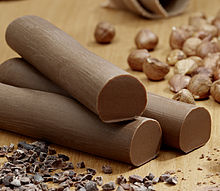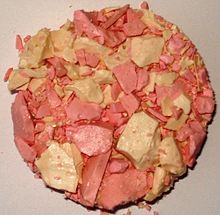nougat
Under Nougat (also nougat , the or: or hazelnut, s), various confectionery materials or manufactured therefrom confectionery understood, and in principle to distinguish between a dark nougat with cocoa and white nougat without cocoa - the two species are not related. In Switzerland , brittle leaves are also known as nougat. Nougat comes in many different flavors: classic nougat, almond nougat, light nougat, dark nougat, layered nougat, brittle nougat and cream nougat.
etymology
The French name nougat for the white nougat is borrowed from the Occitan nogat , a derivation of okz. noga "nut" ( lat. nux ).
Dark nougat
origin
Dark nougat has its origins in from Turin originating Gianduia (also gianduja ;. Cf. Giandujafolklore , a traditional figure of the Carnival in Piedmont) and is known in the Romance languages also under that name. The Gianduia arose as a result of high tariffs that were levied on goods from England and its colonies during Napoleon's time ( continental barrier 1806–1814), including cocoa: In Turin, where the art of chocolate processing was already practiced at that time, chocolate was roasted with it and then stretched ground hazelnuts . A short time later, this fix solution became a well-known specialty.
There is a first written reference in Antonio Bazzarini's work "Piano teorico-pratico di sostituzione nazionale al cioccolato" (German: "Theoretical-practical plan for the national substitute for chocolate"), in which he describes how to use a mixture The cocoa content can be reduced from sweet almonds, lupins , grains and sugar syrup. From 1832 Pier Paul Caffarel worked in Bianchini's chocolate factory, who after Bianchini's death began to produce on an industrial scale. Michele Prochet is said to have recognized in 1852 that roasted hazelnuts can increase the taste experience many times over. At first he began on his own - later together with Caffarel's son Isidore - to produce refined chocolate specialties with "Pasta Gianduja".
In Turin, Gianduia is offered in small pieces under the name " Gianduiotto " as a typical local specialty. Mostly hazelnuts from Piedmont are used here, as the “tonda gentile” variety grown here is characterized by its finer taste and less susceptibility to spoilage than the Turkish hazelnuts that are predominant in food production today.
Meanwhile, the name Gianduia is also known in Germany, where it is used for finer chocolate specialties in addition to the French name Praliné .
Manufacturing
The main ingredient in dark nougat is hazelnuts . The kernels are roasted at 150-180 ° C for about 20 minutes and then cooled and ground in a mill. This creates a raw mixture similar to marzipan , to which lecithin can be added to better bind it. Brittle nuts are added to the paste if the nougat is to be darker. The hazelnut mass is kneaded with powdered sugar , cocoa butter , couverture , vanillin and milk powder and rolled until it forms a homogeneous mass. Vegetable fats such as soy fat are optionally added. When the mass gets cooler, it solidifies and the nougat can be plated and cut.
differences
The ratio between hazelnuts, chocolate and sugar ultimately not only determines the taste, but also the consistency of the mass, which can be hard but also creamy.
Dark nougat can be distinguished in taste and consistency. A high proportion of hazelnuts (over 30%), fresh roasting and the use of hazelnuts of the current harvest and high-quality varieties are some quality indicators, as well as the degree of grinding. The perception limit of the particles is around 30 µm, above this the mass appears sandy or, in the case of particles well above it, brittle-like. Smaller particle sizes lead to a lower viscosity and thus better melting of the mass. On the other hand, there are craftsmanship qualities that have an intentionally coarser degree of shredding. This also leads to differences in taste, as different substances reach the taste buds due to the particle size.
use
Nougat can be enjoyed straight. In addition, nougat and nougat mass are used in fillings and masses for baked goods as well as for the production of pralines and other sweets . Another nougat product is used in particular as a spread used nougat cream , which differs from the nougat that their vegetable fats are added.
White nougat

Largest nougat in the world in the Palais des Bonbons et du Nougat , 96 × 130 × 112 cm, 1300 kg
The white nougat product group includes foamed sugar products known as gaz, Turkish honey, oriental honey, Dutch nougat, Montélimar nougat, Madolato (Μαντολάτο), turrón and torrone.
White nougat consists of a foamy, whipped, light mass of egg whites and honey (and mostly sucrose and glucose syrup as a cheaper honey substitute ), as well as other ingredients such as seeds ( almonds , nuts or pistachios ), candied fruits (e.g. cherries or grapes). and partly gelatin . The recipes vary depending on the region of manufacture. White nougat has a soft to semi-firm consistency, depending on the recipe and the water content (10% and less).
origin
Based on Greco-Roman and Persian roots ( Gaz ), great traditions in the production of white nougat have developed for centuries , particularly in France (Montélimar nougat), the Iberian peninsula ( Turrón ) and Italy (Torrone). Belgian noga, Dutch soft nougat, Turkish honey and halva (Asia and Eastern Europe) are similar desserts. None of them contain cocoa in the basic recipe.
French Montélimar nougat
It is a confectionery specialty from the French city of Montélimar in northern Provence .
The history of Montélimar nougat is said to go back to the Greeks, who brought it to Europe. The recipe came to Provence via Marseille , where production began in the 16th century with the introduction of Asian almond trees . As nux gatum , d. H. It has been mentioned since 1700 as "(cake) with nuts". In Montélimar itself, however, the folk etymological explanation is preferred that the name is derived from tu nous gâtes (“you spoil us”).
The nougat de Montélimar consists of water , lavender honey , egg whites , roasted almonds, pistachios , sugar , glucose syrup and vanilla . In the Montélimar nougat, the core content must be at least 30%, of which 28% are roasted almonds and 2% pistachios. Only this nougat may bear the Appellation d'Origine Contrôlée (AOC) seal of approval and the name Nougat de Montélimar . The egg whites are mixed with heated honey, a boiled sugar solution is added and mixed with the other ingredients. There are different versions: hard or soft, white or colored and mixed with different flavors. In cheaper nougat, some of the almonds are replaced with hazelnuts or peanuts and cheaper honeys are used.
Gaz
Gaz is Persian nougat from Iran , which is made from the milky juice of the tamarisk plant , whipped egg white, sugar, rose water and pistachios or almonds .
Dutch nougat
An industrially manufactured and inexpensive confectionery is offered under the brand name Nappo and its own name “Holländischer Nougat”. A similar product is made by Dresse Nougat in Aachen, a small, family-owned factory. Both companies produce the product in diamond shape.
Turkish nougat
The Turkish nougat (Turkish: Koz Helvası, see Halva ) is often referred to as Turkish honey . This is an older name for white nougat.
Turron
Spanish turrón consists of at least half of almonds.
Torrone
In Italy and Switzerland, comparable products are called torrone . The Piedmont region in particular is known for it.
Individual evidence
- ↑ Peter Prantner: The Nougatei and Napoleon's embargo. First written reference from 1813. In: orf.at. March 30, 2013, accessed March 30, 2013 .
- ↑ Stephen Beckett: The Science of Chocolate . Royal Society of Chemistry.
- ↑ Jean-Pierre Wybauw: chocolates: 60 new recipes from Jean-Pierre Wybauw . Matthaes, ISBN 978-3-87515-117-6 , pp. 80 .
- ↑ a b c d e Hartmut Hoffmann: Zuckerwaren, in: Hartmut Hoffmann, Werner Mauch, Werner Untze: Zucker und Zuckerwaren, Hamburg: Behr's Verlag, 2000 ISBN 3-86022-937-0 , p. 140.
- ↑ Food lexicon Dr. Oetker, 4th edition 2004, article Turkish honey and white nougat .



